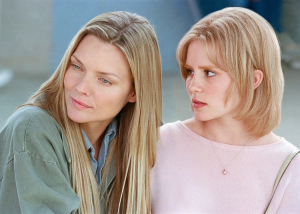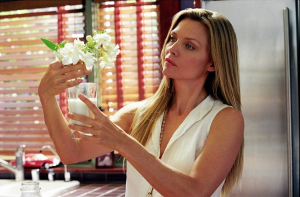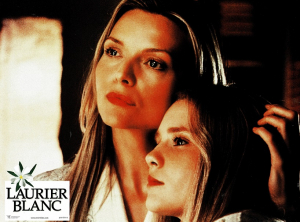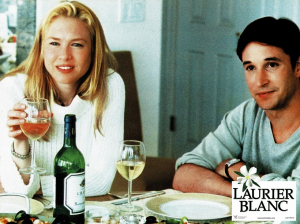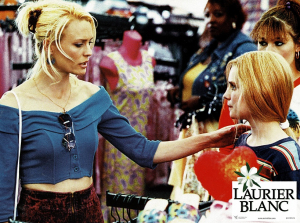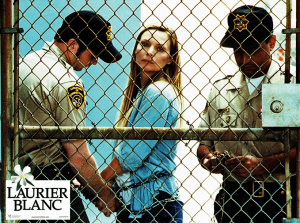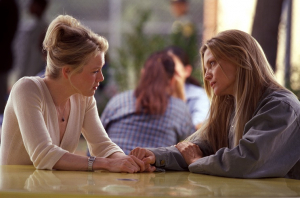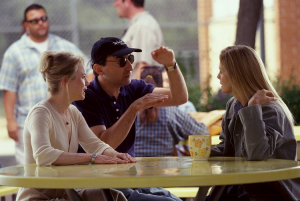White Oleander
– Production Notes –
Oleander can be poisonous… So can a mother’s love White Oleander tells the unforgettable story of Astrid, a girl whose odyssey through a series of Los Angeles foster homes – each its own universe with its own laws, its own dangers, its own hard lessons to be learned – becomes a redeeming journey of self-discovery. Based on the acclaimed best-selling novel by Janet Fitch, White Oleander follows a young woman’s journey through hardship and loss to maturity, joy and true independence.
After her uncompromising but seductive mother Ingrid (MICHELLE PFEIFFER) kills her boyfriend for abandoning her, fifteen-year-old Astrid (ALISON LOHMAN) witnesses her mother’s arrest. It’s an event that will change the course of both their lives.
Suddenly, young Astrid is on her own.
Shuttled through a series of foster homes (and foster mothers including ROBIN WRIGHT PENN and RENÉE ZELLWEGER), Astrid struggles to master the techniques she needs if she’s to survive the unyielding and often harsh world she is thrust into. Astrid tries desperately to forge her own identity within her ever-changing environment. From behind bars, Ingrid’s powerful influence is the only constant in Astrid’s life. For good, and for bad…
In the three years that mark her passage from child to adult, Astrid must learn the value of independence and courage, rage and forgiveness, love and survival, to earn her freedom from the past.
Warner Bros. Pictures presents, in association with Pandora, a John Wells Production; White Oleander, starring Alison Lohman, Robin Wright Penn, Michelle Pfeiffer and Renée Zellweger. Directed by Peter Kosminsky from a screenplay by Mary Agnes Donoghue and based on the best-selling novel by Janet Fitch, White Oleander also stars Billy Connolly, Svetlana Efremova, Patrick Fugit, Cole Hauser and Noah Wyle. John Wells and Hunt Lowry are the producers; Kristin Harms, Stacy Cohen, E.K. Gaylord II and Patrick Markey are the executive producers. Donald Graham Burt is the production designer; Elliot Davis, the director of photography; Chris Ridsdale is the editor. Music is by Thomas Newman.
White Oleander will be distributed domestically by Warner Bros. Pictures, an AOL Time Warner Company, and internationally by Pandora, a division of Gaylord Films. Rated PG-13 by the MPAA for “mature thematic elements concerning dysfunctional relationships, drug content, language, sexuality and violence.”
www.whiteoleander.com / AOL Keyword: white oleander
PRODUCTION INFORMATION
From Book to Film
When producer John Wells received an early copy of Janet Fitch’s novel, White Oleander, he read it in one night and immediately optioned the film rights. “The characters were beautifully drawn,” comments Wells, a renowned writer and director as well as a producer and one of the creative forces behind ER, The West Wing and Third Watch. “It’s an extraordinarily well-written book with indelible characters and a very uplifting message. I found myself fully involved in Astrid’s journey.”
Wells was impressed by how the story illustrates a universal theme about growing up, weathering the myriad experiences that help define us as individuals and establish an identity apart from our parents. “Whether or not we experience the kind of adversity that Astrid encounters, one way or another this is a passage we must all navigate as adolescents,” says Wells. “Part of becoming an adult is the realization that our parents
have a great many of their own failings and frustrations, that they are human and not omnipotent. Their love, though genuine, may be as imperfect as they are, and we have to accept that for what it is if we’re to move forward.”
Producer Hunt Lowry felt a similar strong reaction to White Oleander. Having read the script one evening, he was on the phone the next morning to arrange a meeting with Wells to discuss moving forward with the project. A man who receives countless scripts and proposals, Lowry trusts his instincts in selecting projects to produce and often bases his decision on how much he is “genuinely and emotionally moved, in a positive way” by the material. “What sets a story like White Oleander apart,” Lowry explains, “is that while I’m reading it I can forget that I’m reading a script or watching a movie because I become so immersed in the story itself.”
Within two weeks of its publication, White Oleander was chosen by Oprah Winfrey as the May 1999 selection for her book club and it rose to top-five positions on the bestseller lists of newspapers around the country including The New York Times, Los Angeles Times, Washington Post and USA Today. The book touched readers who identified with its life-affirming message. As of August 2002, there are more than 1.5 million copies in print. White Oleander has also become an international success, appearing on best-seller lists in the U.K. and Holland, with rights sold in 25 countries.
To translate the much-admired novel into a compelling screenplay without compromising the narrative or the characters, Wells enlisted Mary Agnes Donoghue, whose screenwriting credits include Deceived, Paradise and the soulful adaptation of Iris Rainer Dart’s novel for Beaches.
The intention was to present the story as fully as possible, allowing for the time constraints of film. “We didn’t acquire the book with the intention of using just a piece of it and extrapolating from that into something else,” Wells explains. “We liked the story in whole and wanted to make as faithful an adaptation as possible, knowing that we’d have to reduce the scope of it. Readers will notice that we had to condense some of the episodes. Mary Agnes did an excellent job of making selections from the book and then Janet read her draft and provided some very helpful notes.”
Lowry, whose recent producing credits include the successful screen versions of two very popular novels, A Walk to Remember and Divine Secrets of the Ya-Ya Sisterhood, emphasizes the sensitivity with which the filmmakers approached their task: “When you’re working with a book that a great many people already know and love, there’s a tremendous obligation to do it justice. It puts more pressure on us, certainly, but it’s a valuable kind of pressure because it produces the best results.”
Ultimately, a screenplay was developed that had the author’s complete approval – a rare occurrence, since novelists are often excluded from the development and production process. “I was fully prepared to put the book into their hands and just hope for the best,” says Fitch, “because other writers had told me that’s what I should expect. So I was surprised and thrilled when they invited me to read the script and later to attend the first read-through once the cast had been assembled.
“What a pleasure it was,” she says of the experience, “to hear those words being said by people who would bring these characters to life, characters that I had lived with for four years and who had previously only existed in my own mind. It was like stepping into a dream.”
While the screenplay was being prepared and Wells was still considering how to adapt the story visually, a friend sent him a tape of Warriors, an award-winning 1999 BBC miniseries about peacekeepers in Bosnia, directed by Peter Kosminsky. Impressed by the director’s deft and sensitive handling of the difficult subject and his ability to weave together narrative threads from multiple points of view, Wells felt that Kosminsky had precisely the right sensibility for White Oleander. “This is exactly what we need,” Wells recalls thinking, “someone who can work with characters in a real and restrained manner while sacrificing none of the honest emotion and never slipping into melodrama.”
Kosminsky, who lives and works in England, was originally reluctant to accept the project when Wells approached him, as his schedule was already full and a Los Angeles shoot would mean time away from his family. He was, he recalls, “in the middle of a run of films I was making in Britain, with one project in particular pretty much set to go when I read the script.” Having read the script, he then read the novel and found that he “simply could not resist it. I was incredibly moved by the story of this young woman and her voyage.”
Although Astrid’s experiences in various foster homes propel her development as an individual, it was never the intention of Janet Fitch nor the filmmakers for White Oleander to be an exposé of the foster care system. Kosminsky understood this implicitly and that was another reason why Wells was convinced that he was the right director for the project. “Some people automatically assume it’s an indictment of the foster care system but that’s not what the book is about,” says Wells. “It’s about how a young person, no matter the circumstances, can find his or her own identity and emerge from the shadow of a very powerful parent. The foster homes are just the setting for this metamorphosis. As it happens, it’s Astrid’s bad luck to fall into a series of placements that are far from ideal.
“What emerged in my initial conversation with Peter was that he grasped the meaning immediately,” Wells continues. “He knew it was essentially about the relationship between a mother and daughter and about growing up.”
Lowry concurs, adding that his first meeting with Kosminsky left no doubt that the director “understood the arc of this young woman’s journey and all that it entailed; every nuance, ordeal, conflict.”
As Kosminsky describes it, “Here is a girl who spent her entire childhood walking on eggshells, living with a wonderful, charismatic but completely capricious, selfish and destructive mother. Ingrid is difficult and unpredictable. At her best she is a gifted artist as well as a perceptive, loving and utterly charming presence. But she’s not always at her best. As a child, I imagine Astrid would always be holding her breath, never sure what her mother’s mood would be on any given day or how she might react to things.
“With no real friends her own age,” Kosminsky continues, “Astrid sits on the edge of adult society, observing and sketching what she sees on a drawing pad. She idolizes her mother, who has raised her single-handedly. Ingrid is fond of saying that they are descendant of Vikings and Astrid imagines the two of them as Viking warriors, a united force against the world. Then, reality intrudes in a most dramatic way. Her mother is snatched away from her in an instant and she’s left to fend for herself in a very hostile world.”
As Astrid is placed in each new foster home in the years following Ingrid’s incarceration, Kosminsky observes that initially she continues to behave as she did with her mother, trying to figure out what is required of her and then doing it. “Chameleon-like,” he says, “she tries to assume the colors of each new world.”
Her efforts, however, are largely undermined by Ingrid, who communicates with her daughter from prison and criticizes any new influences in Astrid’s life that don’t meet with her own idealistic standards, causing Astrid to question whatever little progress she has made. “I’m only protecting you from those people,” Ingrid claims, but, as John Wells points out, “she is primarily interested in protecting herself – in this case, from losing control of her daughter. This is the meaning behind Janet’s choice of oleander as a symbol and the book’s title. It’s a beautiful flower that protects itself by making its own poison.”
With the passage of time and a series of experiences, some of them traumatic, Astrid’s true strength and character begin to emerge. Increasingly distanced from the
powerful influence of her charismatic and demanding mother and strengthened by the hard lessons learned in one troubled placement after another, she begins to trust her own judgment and make her own decisions. Ultimately, she will see not only her mother but everyone and everything in her life with increasing clarity – as they are, not as she would like them to be. Only then will she be truly on her way to becoming an independent woman.
Casting
In the novel, Astrid’s age at the time of her mother’s incarceration is not quite 14 and her age at the story’s end is 19, which was, as Wells describes, “a distance we knew we could not plausibly travel with a single actress.” The filmmakers dismissed the option of using two actresses because that would require a time jump that would disrupt the narrative flow, so they abbreviated the age span to take Astrid from 15 to 18 and committed themselves to finding an actress who could believably make that progression.
After an exhaustive cross-country search in which the filmmakers and casting director Ellen Lewis considered nearly 400 young women, the prospects were narrowed to a series of screen tests and finally Alison Lohman, 21, was cast as Astrid. Lohman, who made her acting debut on stage in local musical theater at age 10, launched her film career in the 1999 drama The Thirteenth Floor and has gone on to appear in a number of film and television projects, including a series regular role on the Fox drama Pasadena. “She has the range and maturity as an actress to span the age range from 15 to 18 and show the emotional changes that Astrid goes through,” Kosminsky says.
As Lowry points out, it was Lohman’s ability to balance Astrid’s vulnerability with her emerging strength that made the character so credible. “If she appeared too strong, the audience would feel that her survival was unquestionable,” he says, “and if she appeared too weak they might think ‘she’ll never make it,’ which can be depressing to watch. What Alison managed to do was convey inner strength while struggling with the natural doubts and insecurity of a girl her age going through such adversity.”
“It’s a tough job,” the director notes, commenting on the demands of the role. “She is in virtually every scene, and she is captivating. She has the kind of face that draws you in to closer and closer shots as you try to explore what’s going on behind her eyes. It was important that the actress who played this part knew how to be very still because Astrid is a watcher and a listener, a girl who sits on the edge of life observing and sketching. Alison has that wonderful quality. She seemed to understand the part inherently.”
Adds Wells, “She has a natural luminance.”
Before there was even a script or talk of a film, Lohman had read the novel and already imagined herself in the role of Astrid. “She was someone I could admire,” Lohman says. “The great thing about Astrid is that she is not a victim, regardless of what she endures. She has an inner strength and resilience that keeps her going. She refuses to wallow in her misery.
“Astrid is an artist and sees things with that perspective,” continues Lohman. “She’s vulnerable and open to things, and tends to acclimate herself to each new environment. She transforms herself into what she thinks each of these foster mothers expects her to be, as she did with her real mother, adapting to their standards while trying not to lose herself completely. It takes time before she gains the confidence to be who she wants to be.”
The filmmakers agreed that the key to portraying Astrid’s mother, Ingrid Magnusson, would be to acknowledge the various strong elements of her personality and avoid presenting her as a one-dimensional villain. “If not handled correctly,” Wells grants, “Ingrid’s extremes can come across as pure arrogance. The character is easy to dislike. The truth is, Ingrid is extremely narcissistic but that does not mean she doesn’t love her child. Maintaining a balance between the two is very difficult.”
Coincidentally, the filmmakers’ first choice for Ingrid was the same actress Janet Fitch had in mind while developing the character – Michelle Pfeiffer.
“Michelle certainly has a lock on Ingrid,” Kosminsky attests. “There’s a directness and authority to the way she plays the part that is quite compelling and very moving to watch. Ingrid is an extraordinarily difficult character.”
“I’m not sure it’s possible to completely understand Ingrid,” Pfeiffer offers. “I think she’s somewhat of an enigma even to herself. She’s the ultimate purist, in a way, unyielding and unforgiving in her views and standards and the expectations she has of her daughter even at that young age. To some extent I admire that quality, the unwillingness to compromise, knowing that there will ultimately be a price to pay for it.
“What she says about people is harsh but it’s usually the truth,” Pfeiffer acknowledges. “She says things that no one else will say because it isn’t nice, but Ingrid is not concerned with being nice. She zeroes in on the weakness. It was challenging playing someone who could be so utterly cruel; I had to fight my natural impulse to soften her and take some of the edge off.”
For the role of Starr Thomas, Astrid’s first foster mother, a flamboyant and volatile former stripper turned born-again Christian, Kosminsky’s cast Robin Wright Penn, whose screen presence he describes as “natural and realistic. She’s so authentic that often when she began to speak I’d catch myself, thinking for a moment, ‘is she talking to me?’ before realizing that she was doing her lines. There’s no theatricality about her performance.
“Robin took a role that could easily slip into cliché and turned her into a completely genuine and even sympathetic person,” Kosminsky elaborates. “Starr is a very tough, hard-edged, a woman who is absolutely dangerous and vindictive, but is also tragic.”
The performance required Wright Penn to inhabit a character completely unlike herself, a welcome opportunity for which she credits the director “for having the faith to cast against type and not go for the obvious choice.” She jokes that in playing Starr she found herself wearing high-heeled white pumps for the first time “and spandex pants, during the day, outside of aerobics class. It was a very campy wardrobe.”
Regarding Starr’s motivation for fostering Astrid, Wright Penn acknowledges the financial element (“it’s her only income”) but goes deeper to find a reason more central to Starr’s personality. “More importantly, it’s her redemption,” the actress says. “In a selfish way, it’s her salvation for having sinned, for having been an alcoholic and a stripper. Astrid is the third foster child she has taken in. With her new religious perspective, she believes that this philanthropic lifestyle is going to make up for her past and keep her clean.”
Renée Zellweger, already a fan of the book, was cast in the role of the tender and fragile Claire Richards, who becomes another of Astrid’s foster mothers. “Renée has a capable and down-to-earth quality about her that we needed for the character of Claire,” explains Kosminsky. “It would make the ultimate revelation of her frailty much less predictable. Renée embodied Claire – a profoundly vulnerable woman — in a way that avoided the obvious displays of vulnerability.”
“Claire is an interesting dichotomy of weakness and strength,” Zellweger says, offering an insight into her character’s psychology. “She’s very generous and draws her strength and self-esteem from giving to others.
“Claire’s husband does not appreciate her desire to give, he perceives it as neediness and weakness,” Zellweger explains. “Astrid turns that around for her because she is in such need of that kind of attention, nurturing and kindness. Each of them enjoys being the most important thing in the world to someone else for the first time. It gives Claire a purpose but it also creates friction between her husband and herself.”
For the brief but significant part of Ingrid’s faithless lover, Barry, Kosminsky selected Scottish-born actor and comedian Billy Connolly, whose work he knew well from a wealth of film and television productions in the UK. As Connolly puts it with his customary wit, “They were looking for someone to play the part of a confident bum, a slob and a sexist, and of course Peter phoned me.”
Cast mate Michelle Pfeiffer confirms Connolly’s reputation as one of the most popular comedians in the UK, saying, “He was hysterically funny off camera, which was a relief after our very angry dramatic scenes together. I had a wonderful time working with him.”
The filmmakers cast versatile actress and acting instructor Svetlana Efremova (K-19, The Prince of Central Park) as Russian émigré Rena Grushenka, who provides Astrid with the last of her foster homes. A woman with a Bohemian lifestyle but a very conservative financial outlook, Rena is already fostering two teenage girls whom she treats like employees. Together, they raid trash bins from upscale neighborhoods and then sell their salvaged merchandise at flea markets. Nearly an adult at this point and already transformed from her former dreamy self into a more realistic and self-possessed young woman, Astrid fits in comfortably with Rena’s unconventional routine, where she finds exactly what she most needs – the freedom to be herself.
“Rena is a free bird,” says Efremova of her role. “She’s independent, confident and hungry for life. I fell in love with this simple, courageous woman who smoked and drank and had a good time, who didn’t ask for the meaning of life but preferred to just enjoy it as it was. She’s honest and has a good sense of humor. It was good for Astrid to be around her.”
Rena, like Astrid, is a survivor.
A Russian immigrant herself, Efremova based her characterization “partly on imagination and partly on my knowledge and observation of Russian people in America,” she says, specifically their commitment to hard work and their desire to make a new life for themselves. “I did not want to portray Rena as greedy, regardless of her emphasis on materialism,” she says, delving deeper. “I saw her as a woman who came to this country with nothing and made her own way, who dove fully into the American life, learned its slang and rock music and also learned how to make money to live.”
This point is made in a scene in which Rena, Astrid and the other girls are setting up shop at the flea market. At one point, Astrid recognizes some fancy dresses that Claire had once given her, now pulled out of a garbage bag by Rena’s hand and feels a flush of emotion. But Rena’s practical response brings her quickly back to earth. “Sentimental is stupid,” the born-again capitalist admonishes her, “Is good to make money.” It is then Astrid herself who spots a buyer and makes the sale.
Delicately woven in between her several foster homes is Astrid’s tentative relationship with another displaced teen, Paul, played by Patrick Fugit, who recently earned praise for his breakthrough role in Cameron Crowe’s Almost Famous. Unlike Astrid, who was torn away from a mother who loved her, Paul never knew the affection of either parent and has been coping with life in foster care long enough to have become philosophic about it.
“Paul is the only non-judgmental person in Astrid’s life,” Kosminsky says. “Unlike all the other people she knows, he does not try to influence her or censor her in any way. He talks candidly and unemotionally about his experiences. I believe he provides clarity for her at a time when things look very dark.”
While staying with the brash Starr Thomas, Astrid gets to know Starr’s live-in boyfriend, “Uncle Ray,” played by Cole Hauser (Tigerland, Hart’s War, Good Will Hunting) whose quiet, thoughtful nature better suits her. Ray seems simple enough on the surface as a decent, content, hardworking and kind-hearted guy, but his increasing closeness with Astrid reveals a deeper nature of restlessness and regret, as well as increasing guilt about his physical attraction to this newest addition to the family.
As Ray, Hauser is called upon to convey these nuances with limited dialogue in fitting with the character, and in a limited amount of time as Ray’s relationship with Astrid quickly ignites Starr’s jealousy and puts an abrupt end to that particular foster home experience.
For the part of Claire Richards’ husband Mark, Wells thought of his friend and colleague Noah Wyle, longtime star of ER, a series Wells helped launch and for which he serves as executive producer. But, mindful of the relationship, he didn’t want the director to feel pressured into casting Wyle so he put the actor’s name on the list and waited a beat. It turned out that Kosminsky had Wyle in mind for the role as well and was, as Wells recalls, “only waiting for Claire to be cast so that he could be absolutely sure the two stars would be a plausible match – which, of course, they were.”
Wyle, who jokes that he jumped at the chance to play Mark because, “it’s been a lifelong dream of mine to be a philandering husband,” was interested in handling a role so unlike his popular television persona. “I play such a morally responsible honest guy on ER ” he says, “It’s good to do something different.”
Not only did Wyle completely understand Mark Richards’ personality, which he describes as “controlling and superficial,” he saw the real reason behind the couples’ decision to foster a child. “Mark and Claire have a troubled marriage and think that maybe having a child will help,” he says. “But they’re not ready to commit to an adoption so they take in an older child to see how they like it; like buying a dog. The truth is, they’re more interested in the trappings of parenthood – someone to shop for, to dress up, to play with – than with actually being parents. Unfortunately, like the other placements Astrid goes through, the reason why these people have taken her into their home is to help themselves more than to help her.”
As to how he guided this remarkable ensemble cast, Kosminsky says, “I’ve always been an actor’s director. My twin roles are getting the script and the casting right and I take ages over both processes, often to the despair of my producer colleagues. Then I like to rehearse quietly, away from the chaos of the production office, for just a week. If more than a week, you can over-work the material, risking that feeling on set that you have never quite recaptured the way a scene worked in the rehearsal room. In a week you can flirt with the material, romancing it in earnest on location.”
Once on set, the director prefers not to rehearse at all. “Wherever possible I shoot straight away so the actors come up to full performance pitch in front of the camera,” he explains. “Some actors do their best work in the first couple of takes when they are really listening to what the other actor is saying to them and I like to capture that on film rather than watch it go by on my monitor during rehearsal. The actors on White Oleander gave extraordinary performances but what really struck me was how open they were to working in this slightly unusual way. Whether behind the closed door of the rehearsal room or later on set, their focus was entirely on exploring and bringing these characters to life. They give mesmerizing performances, real and unflinching, that complement each other beautifully. All I had to do at that point was stand back and watch.”
Kosminsky’s technique gets high praise from the cast, who credit his thorough preparation with allowing them to avoid endless retakes. “He has such a clear idea of what he wants,” says Renée Zellweger, “that he doesn’t rely on a monitor. There’s no playback. He watches a scene and if it’s right he says ‘Yes, that’s it’ and it’s done. He doesn’t need to watch it again or get 20 additional takes.”
The Director’s Approach
Once Kosminsky came on board he worked with Wells and Donoghue to incorporate even more of Fitch’s original ideas and language into the script. Together they maintained what he refers to as “a writer’s approach” to the adaptation, protecting the core of the project because, he says, “I loved the source material and wanted to use as much of it as I could.”
One slight alteration he made was to exclude from the film those few scenes depicting incidents that Astrid herself could not have witnessed. “It struck me straightaway,” he explains, “that this is Astrid’s story and the film must maintain her perspective throughout. She leads us through this world and we meet her foster families and absorb the various incidents along with her. We never see anything that Astrid herself could not have seen.”
In keeping with Astrid’s point of view, the camera follows her closely and never gets ahead of her. It keeps pace with her as she explores each new environment and then seeks her response by coming around for reaction shots, a method which supports Kosminsky’s desire to “make people feel that they are really entering this world, that it’s real and authentic rather than theatrical.”
Director of photography Elliott Davis used mostly hand-held cameras, which helped capture the intimacy of the subject matter. Says Wells, “Once the advent of steadicam revolutionized the industry, most people stopped using hand-held cameras. But filmmakers are realizing that the steadicam forces you into a very fluid style. Peter was after something more immediate and raw.”
Due to the episodic nature of the story, Kosminsky found himself directing a series of vignettes and fitting them together. Each foster home had its own cast, setting and set of circumstances with the traditional storytelling arc of a beginning, a middle and an end — a structure that Kosminsky likens to life. Wells compares the overall effect to a pointillist painting: “When you stand up very close, you see only the little dots of paint. You have to stand back a bit to see the cumulative effect of those countless dots of paint and the beauty of the picture as a whole is revealed.”
Springtime in Southern California
The city of Los Angeles is part of the fabric of White Oleander. As Astrid is repeatedly relocated from one placement to another, each opens as another self-contained mini-world with its own identity and way of life that she must learn, which is similar to how the various districts within the borders of that sprawling city actually function.
Understanding this, Kosminsky did not consider filming anywhere else. “It would have been appalling,” he says, “particularly for those who loved the novel, to see it set elsewhere. Besides, as a foreigner, I was intrigued by the idea of filming in this city, which is entirely unfamiliar to me. I wanted to see firsthand the places that Janet Fitch referenced in her book.”
In the course of the 40-day shoot, beginning in April 2001, the company filmed on 58 locations throughout the Los Angeles area, including Hollywood, Tujunga, Sunland, Echo Park, Silverlake, Monterey Park, Santa Monica, Malibu, Castaic, Manhattan Beach and Pasadena.
Astrid’s journey begins in her mother’s Hollywood apartment, which is predominantly stark and white. It’s clearly an artist’s space, reflective of Ingrid’s personality, an aesthete’s idea of beauty. Touches of Ingrid’s well-traveled Bohemian lifestyle are evident, but the most commanding details are her own dramatic artworks. One large mixed-media photo installation dominates an entire wall of the 1920’s Hollywood locale.
In jarring contrast is Starr’s doublewide trailer in the rural and undeveloped Tujunga Wash, with its cluttered, over-the-top, gaudy décor that matches Starr’s own wardrobe of hot ‘70s colors and eclectic thrift store finds. On moonlit nights Astrid can sit by herself on the tiny porch step and look out into the vast desert landscape, an image of profound loneliness and beauty.
Astrid next finds herself in Claire Richards’ Malibu hilltop home with its spectacular view of the shimmering Pacific Ocean. The classic contemporary set, with its white-on-white and beige hues is both opulent and restrictive. It reflects the outward serenity and inner sadness of the deeply troubled Claire.
By the time she arrives at her final foster home, the crowded Silverlake apartment of Russian émigré Rena, Astrid has given up trying to blend into her ever-changing surroundings and instead carves out a personal corner for herself amid Rena’s eclectic flea market junk.
Even the weather plays a subtle part in the story, and in this way the authentic Los Angeles locations cooperated with the filmmakers. Throughout production the air often snapped with static electricity from warm Santa Ana winds that blow into town every spring – the winds that so inspired free-spirited Ingrid when her mood was upbeat and that Kosminsky was careful to capture on film. Southern California native Michelle Pfeiffer knows those winds well. “I grew up with them,” she says fondly. “We lived in an area that wasn’t fully developed at that time. I have vivid memories of giant tumbleweeds rolling down my street when I was a child.”
